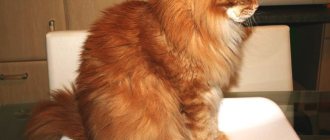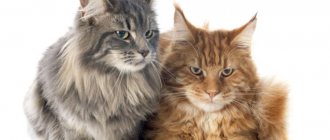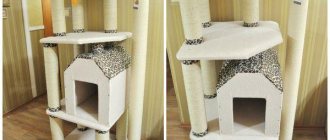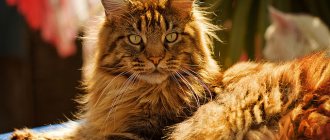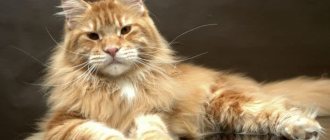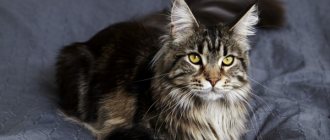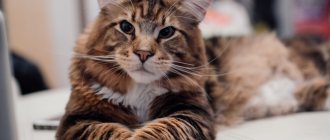A distinctive feature of cats is considered to be a love of freedom and independence; the upbringing of Maine Coons is questioned by the owners of the breed. The arguments are based on a common myth - cats cannot be trained. “Cat-dogs” is the name given to the breed among Maine Coon breeders by adherents of the idea that a cat can be trained. A cat is unusually similar to a dog; he is even taught the command “fetch” (bring what you asked for).
Raising a Maine Coon: nuances and features
Harsh measures in raising cats are completely unacceptable. Not only will this not help solve the problem, but it will also turn your pet against you. This especially needs to be taken into account when raising a balanced, but self-respecting Maine Coon.
Take it for granted that the harshest punishment for your pet should be a reprimand made in a stern voice.
Do not hit your pet under any circumstances; the Maine Coon will never forgive anyone for such treatment. Communicate with your kitten more often, talk to him, accustom him to your intonations that express approval or dissatisfaction.
Character traits
Distinctive features of cats of this breed:
- playfulness;
- accuracy;
- peacefulness;
- sociability;
- learning ability;
- adaptability;
- unpretentiousness.
It is worth noting that these qualities are both enhanced and suppressed in the process of education. It is necessary from the first days of moving the pet to a new place of residence. It is easier to raise an affectionate, playful cat, as well as teach it commands, if you tame it right away. Coons are easy to train, but general methods developed on dogs will not work.
Advantages and disadvantages
Such animals find a common language with the children of their owners.
Playful and active. She loves children, is understanding, trainable, and has a phenomenal memory. She is obedient, easy to care for and gets along well with people. She gets along with children without problems and will not cause harm, even considering her large size, she will treat the baby carefully and condescendingly, and can become his devoted friend and protector.
It has a fairly long and thick coat. Problems arise without proper care and attention; wool spreads throughout the home, and especially collects on carpets and furniture. Having large sizes and weight (adults reach 1.2 m in length and up to 15 kg in weight), they can break household items through negligence, tear curtains and tulle. Without a scratching post, they damage wooden and upholstered furniture by tearing off the covering.
Behavior
Living with a Maine Coon, an attentive owner will notice changes in the animal’s behavior in a direction that is close to themselves. High intelligence and the ability to learn contribute to the transfer of the owner’s character traits to the cat’s behavioral characteristics. Great activity, curiosity, and playfulness are characteristic of young individuals. With age, the pet becomes calm and balanced. Likes to watch what is happening from above. The predator instinct is developed, the cat will catch pests in the house and destroy flies. He treats strangers with fear, but does not show aggression. Makes friends with a new person if he shows respect and friendliness.
Punishment word
A similar word could be “fu”. When your pet learns to understand the meaning of this word, you will not have to resort to other methods of disapproval. This word must be pronounced in a loud, unpleasant voice, looking the pet straight into the eyes.
Touch his nose with your finger. This gesture is considered to be an educational gesture by a mother cat.
If these measures do not help, you can pinch the cat by the ear or lightly spank it with a newspaper, but under no circumstances not with your hand. The punishment word should be unpleasant. It is important to remember that the pet must understand why he is being punished, then he accepts and understands it.
Training or communication?
Training cats has always been considered almost impossible, and not very necessary. However, Maine Coons can be trained to follow simple commands. Typically, the desired skill is developed and reinforced during the game. Each cat has its own inclinations and favorite activities - if you watch your pet and understand what he likes to do, his personal talent can be developed.
You can teach a cat to come to its owner when called - for this it is necessary that the cat’s own name is perceived as something positive and pleasant. You can reinforce this behavior with a treat, affection or play.
You can start training at the time of feeding by calling the cat by name and putting food in the bowl. Subsequently, this technique can be used in other situations, always observing the principle of encouragement. Maine Coons love to play, hunt for objects, and, accordingly, carry toys in their teeth. This play behavior can be easily reinforced and developed by teaching your pet to fetch a thrown object on command. It is also possible to train a coon to give a paw. First, they carefully take and lift the paw of a sitting cat, always accompanying the action with the command “Give me your paw” and rewarding the animal with a treat. Then they extend their palm, repeating the command, and if the coon responds by giving his paw, the pet is rewarded again. If the pet does not react, they carefully take it by the paw again, repeat the words of the command and treat it tasty. Gradually the skill is consolidated. It is important not to force your pet to perform actions that are unpleasant or do not arouse his interest. Following commands and training in general is only one of the moments of communication between a person and a cat, and not at all an end in itself.
Appeal word
In order for your pet to understand that you are calling him, be sure to pat your hand on the place where your pet should be. For example, on an armchair or sofa.
“Come to me” or “come here” should cause the correct reaction, namely the pet’s approach to the right place.
You can call a cat to give him food, pet him or communicate, but not to give him a tasteless medicine or punish him.
Give your pet as much attention as possible, talk to him, educate him. Then your communication will bring you only pleasure.
Gingerbread and spray method
If there are bad qualities in a pet’s behavior that need correction, the principle of prohibition is used. Physical force, even a spanking, is strictly excluded. The only thing that can be used as negative reinforcement is a spray bottle of warm water. With its help, you can wean active and inquisitive Maine Coons from jumping on tables or scratching furniture.
Useful reading: How to stop a Maine Coon from biting
[ads-pc-1] There are situations that provoke Maine Coons to disrupt the order. So, for example, a toilet that is not cleaned on time or is in public view will force the pet to look for a clean, secluded place to perform its natural needs. The lack of a scratching post forces him to look for another place for manicure. If a cat feels forgotten, she will find a way to attract attention to herself, and this will not always be a gentle purr - broken vases, torn curtains, and stolen human food from a plate will be used. Sometimes the owner himself is to blame for the cat’s bad behavior: if a coon persistently begs for food, and a person, in order to get rid of the obsessive pestering, still treats the pet, you should not expect that the animal will behave differently next time.
Negative reinforcement is just as effective as positive reinforcement. If your pet is used to scratching the sofa, you can temporarily secure the fabric in which the claws get stuck to the furniture, or use double-sided tape. There are odors that are unpleasant for cats, but neutral or pleasant for humans (for example, citrus aroma) - they can be used to protect chairs, curtains and wallpaper.
How to raise a Maine Coon kitten? Most unlucky owners make titanic efforts to raise God knows what from a cute, trusting animal. And then they blame all their upbringing flaws on the cat. And she's stupid. And vicious. And vindictive. And unclean. And you can’t live with her under the same roof. There are no bad cats, no. There are unreasonable owners. Don't know how to handle a cat? Learn. It's not such a complicated science. True, it requires time and attention. Don't want to burden yourself with troubles? Then it's a lost cause. Leave everything to chance - you will have an uncontrollable cat. Maybe she has instincts. But not at all the ones you expect. Not the same at all! So choose how to live with a cat. Either spend time, but then find agreement and mutual understanding, or don’t waste time, but get plenty of headaches. Raising a cat begins from the moment it crosses the threshold of your home, that is, from a kitten. All adult cats and female cats were once kittens. All kittens will someday become adult cats and cats. All kittens are good, but they need to be understood, they need to be loved, they need to be educated a little. Do you want to raise a good cat with whom you will live happily until the end of her days? Start raising her from the beginning of her days! The kitten you bring home is like a blank sheet of paper. You can write something good on this beautiful blank sheet of paper, or you can completely cover it with obscene words. And the result depends on what you decide to write on a blank sheet of paper. It is not for nothing that in homes where people love their cats, beautiful animals grow up who love people. And in homes where cats are treated like furniture, evil furniture grows. If you have come to replace the cat-mother, then try to become a good mother for the Maine Coon kitten. Nobody tells you that you need to be touched by all the pranks and tricks of the kitten, this is exactly what you shouldn’t do. But you need to teach him to live with you under the same roof, taking into account his age. This is not a hardened criminal neighbor who has returned to your house from prison, this is a little kitten, he doesn’t want to do anything bad to you, he just doesn’t know yet what is good and what is bad. So explain to him, but gently, calmly and persistently. The way you would explain it to your stupid child. Do you hit or grab your one-year-old baby by the scruff of the neck? No, right? Then why are you doing this to a kitten? Is he worse? Worse?! Then in vain the mother cat entrusted you with the upbringing of her child! In general, if a kitten makes you uncomfortable, then you don't need a kitten. Maybe you need a puppy who will grow into a patient and forgiving dog? Or aquarium fish that don’t care if you’re at home or not, as long as you feed them on time and change the water? Or a toy cat that you can throw on the couch and go away all summer? A live kitten requires attention and care. After all, the cat did not pull your hand and did not demand that you take your beloved child away from her. And you took it. If you took him away, please create full-fledged conditions for him, give him what he needs most now - love. Where does education begin? From the simplest point: you tell the kitten that you love him, and he accepts this love and appoints you as Senior Cat-Mom. A normal kitten agrees to follow all your valuable instructions, just give these instructions in a way that he understands. If in the first days you ruin a possible contact, then later it will be much more difficult to do so. In the first days, when he is already confused and afraid, he needs to be given maximum care. There is no need to start communicating with a kitten with punishments for inept or incorrect actions. The Maine Coon kitten, in general, acts correctly, obeying its instincts. If you direct his actions in the right direction, you will then get a good, smart cat; if not, you will be convinced that you have a stupid cat, with whom nothing can be done, just like that. Think for yourself, if you manage to find a common language with a tiger cub or a lion cub, and until some point they live wonderfully in the homes of their adoptive “parents,” then a cat that was domesticated a long time ago is a much easier subject to raise! A properly raised kitten should know what can and cannot be done in the house. You can: walk throughout the apartment in places that do not pose a danger. You can’t: climb into places where there is a threat to life. You need to: visit the litter box for natural needs, eat and drink from your own bowls, sleep in your own house, sharpen your claws on your scratching post. The kitten must be able to wash itself and care for its fur and claws. And the owner is obliged to monitor the condition of the kitten and come to the rescue in time. The owner has no right to shout at his cat, punish him or hit him. It is also advisable to teach the kitten commands that can save his life in an emergency, as well as teach him to ride with a person in a car or other vehicle without fear, sit in a carrier, and walk in a harness on a leash next to the owner. Good luck. Through the pages of Internet sites. From Elena Filippova’s book “Raising Kittens”
Place for a Maine Coon in the house
Before you buy a Maine Coon kitten, you need to prepare certain, maximum comfortable zones for it in your house or apartment, represented by:
- place for a toilet;
- place for feeding;
- play area;
- sector for sleep and relaxation.
The arrangement of the toilet area should provide the pet with convenience and comfort in using the tray . It is strictly not recommended to install a litter tray in the hallway or in the interior space. The area for feeding the animal is most often allocated in the kitchen, where it is necessary to equip a special place with installed containers for water and food.
Bowls can be made of special food-grade plastic, high-quality metal or ceramics . Containers must be stable enough to prevent your pet from knocking them over while eating or drinking.
Important! All Maine Coons are active, but are able to occupy themselves independently, so such pets need to be provided with movement and games, using special play complexes and a variety of toys for this purpose.
The sector for rest and sleep can be represented by several comfortable and reliable beds located at a sufficient height, but outside the zone of negative influence of drafts. You can use special large cat houses or mattresses with a removable, non-allergenic cover. A properly designed play area will allow the animal to maintain physical activity and keep itself in good shape throughout its life.
Maine Coons have a very positive attitude towards surfaces located vertically at different heights, so the best option would be to purchase and install a special, reliable sports corner. Under the installed sports coon complex, it is advisable to lay a fairly soft floor covering that will protect the pet from injury during active games and jumping.
Return to content
Maine Coon Health and Diseases
The breed of these cats is distinguished by excellent immunity and long life. However, they have breed problems:
- Cardiomyopathy of the hypertrophic type is a pathology of genetic nature. This disease affects older cats, manifests itself as pulmonary edema and causes death.
- Back muscle atrophy is a disease that manifests itself at an early age. At the same time, coordination is impaired and muscles are weakened.
- Hip dysplasia – can appear in older pets. This disease causes lameness.
To reduce the risk of these diseases, you need timely consultation with a veterinarian for medical care of your pet.
First vaccinations
The first vaccinations for Maine Coon kittens are given at two months. Vaccines are made against tracheitis, chlamydiasis, calcivirosis, panleukopenia, tracheitis. A week before vaccination, the kitten undergoes an anthelmintic procedure. After three weeks, you will need to repeat these vaccinations, adding the rabies vaccine to them. However, if you do not plan to let your cat out of the house for independent walks, such vaccination is not necessary.
If the cat is not planning to reproduce in the future, sterilization or castration will be necessary - these measures will protect pets from diseases of a reproductive nature.
Grooming
The Maine Coon's magnificent coat requires regular thorough combing - this is necessary in order to prevent the formation of tangles and severe tangles. Combing is carried out using special brushes. For good results, carry out this procedure weekly. Brushing starts from the head, with much attention paid to the belly and armpits, as well as the tail and paws. They require regular bathing, which needs to be done once every few months - the pet is bathed in the bathtub using shampoo and coat conditioner. It is recommended to pay special attention to the cat's tail.
Tray and scratching post training
Maine Coon kittens are trained to use a litter tray and scratching post from a very early age. They, like other representatives of the cat family, can go to the wrong place. Or sharpen your claws on furniture. The tray should be placed in a secluded place, and you need to keep it clean.
At the age of four months they begin to accustom them to a scratching post. Using your example, show how to use it: imitate the movements of the claws with your fingers. As soon as you see that the kitten begins to damage the furniture, bring it to a specially equipped place. Both the tray and the scratching post should be selected according to the size of the pet.
What to feed Maine Coon cats
Representatives of this breed eat both natural food and store-bought food, provided it is of high quality. When it comes to natural products, you need to ensure a balanced diet and all the necessary substances. Your pet's diet should include:
- Lean meats and offal.
- Low-fat fermented milk products.
- Boiled vegetables. For these purposes, they take, for example, pumpkin, carrots and zucchini.
- Porridge – oatmeal, buckwheat, rice.
- Sea fish.
- Boiled chicken or quail eggs.
Big cats sometimes experience joint problems, so you should choose only premium store-bought food, the composition of which is balanced taking into account the characteristic features of the breed.
How to choose a Maine Coon kitten?
The demand for Maine Coon kittens is quite high, and you can see many advertisements for the sale of babies. But, unfortunately, not all sellers are conscientious and responsible breeders, which means there is a high risk of buying a not very healthy kitten or mixed breed. How to choose a Maine Coon kitten so as not to regret it later?
Before you go to choose a Maine Coon kitten, study as much information as possible about the breed, visit exhibitions, talk with breeders and existing owners. This way you will understand whether this breed is right for you, and you will be more likely to determine whether a purebred kitten is being offered to you.
Rules for choosing a Maine Coon kitten:
- Check out the breed standard.
- Don’t buy a kitten from the first ad you come across, even if the price is attractive. Contact an experienced breeder with a proven reputation.
- If the breeder does not agree for you to visit the nursery and meet the kitten’s parents, this is a reason to think about whether you should trust such a seller.
- Pay attention to whether the Maine Coon kitten has signs indicating that it belongs to this breed: a long tail, tassels on the ears, a characteristic shape of the muzzle.
- Be sure to conclude a purchase and sale agreement with the breeder.
- Answer the breeder's questions honestly - this will give him the opportunity to help you choose the Maine Coon kitten that is right for you. And don’t hesitate to ask questions yourself.
- Check to see if the nursery is registered in the felinological system, and if the answer is positive, find out which one.
- Pay attention to the kitten’s appearance, activity, grooming, and playfulness. These are important indicators of health.
- It is better to choose a Maine Coon kitten that is 3 - 3.5 months old. At this age, the kitten already has the necessary vaccinations, has been fed mother's milk for quite a long time and is adapted to the world around it. At the same time, the baby is already ready to part with his mother, sisters and brothers.
In the photo: Maine Coon kitten.
Photo: flickr.com

